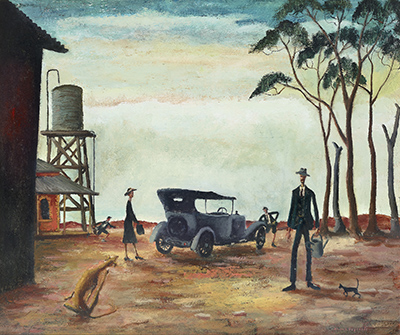In a dry landscape, this haunting Drysdale could set a new record
Sydney Morning Herald, Nick Miller, September 24 2020
Lynne Clarke, daughter of renowned Australian artist Russell Drysdale, has a vivid memory of ‘going to the pictures’ as a young child in the 1940s.
“I remember seeing Pinocchio and having nightmares for years,” the 82 year-old says. “I found it horrifying. I didn’t like going to the cinema much.”
She laughs. Back then, the movies were a big outing, she says. Later, as a teen, she would treasure family movie nights on a Friday or Saturday.
The memories well up as she looks at a reproduction of her father’s 1941 painting Going to the Pictures.
Auctioneers Deutscher and Hackett hope that - despite the pandemic changing the art buying landscape - this painting will set a new record for a Drysdale in their ‘Twenty Classics of Australian Art’ auction on November 11. The catalogue estimates $2.5m to $3.5m, and the artist's current record is $2.98m in 2017 for the much later Grandma’s Sunday Walk.
DRYSDALE lowres.jpg

RUSSELL DRYSDALE
GOING TO THE PICTURES, 1941
oil on canvas
46.0 x 55.5 cm
EST: $2,500,000 – 3,500,000
Executive director Chris Deutscher says it is one of the most important Australian works of art ever to be offered at auction.
“I nearly fainted”, he says, when he heard the owners were willing to sell. The work was originally purchased in 1942 by Clive Turnbull, then art critic for the Herald, then the Argus then The Age, and stayed in the family ever since, though it has regularly hung in major galleries including the National Gallery of Victoria and Art Gallery of NSW.
A dressed-up family are posed in a raw, gaunt outback setting, car at the ready for their night out.
The artist is celebrated for his bold break from the pastoral sentimentality of former generations. His outback, like the real one he lived in, is drought-stricken and uncompromising. The people proud but burdened.
The painting was made shortly after Drysdale was told he couldn’t enlist for the war due to defective eyesight and instead moved with his family to Albury where he oversaw a shearing property.
“I love that group of paintings from the 40s,” his daughter says. “It was his vision, no-one else had been painting like this.”
Despite the ambiguity of its presentation, Ms Clarke says her father deeply loved regional Australia.
“He loved the country. All his life he had friends who were zoologists and naturalists, and his paintings were from all over Australia. I remember once he said to me ‘you never feel lonely if you’re outback, camping’. He just felt part of the land.”
He was a wonderful father, Ms Clarke says. When she was young he would always find little things to show her: “pebbles off the ground, flowers and little tiny things in nature that children see but most adults pass over”.
He didn’t mind when she would make her way into his studio and lean on the drawing board or stand at his shoulder, watching him work.
“I loved watching him. He applied paint beautifully. And he was the most wonderful draughtsman.”
Mr Deutscher says despite 2020’s unusual circumstances his company is shaping up to have one of its best years on record.
There is “pent-up demand” for valuable art, he says. Few people are taking holidays, and more buyers are getting comfortable with online auctions and purchasing significant works without a personal viewing – though, he concedes, some feel “it’s not the right time to be hanging a $2 million painting on their wall”.
International collectors like the Australian market, too, because here it’s possible to buy the best works for a few million dollars – money that wouldn’t get you much in the way of a New York school or French impressionist work.
Mr Deutscher admits to nerves about the upcoming auction.
“It’s a significant historical piece of art,” he says. “This is big money, it’s a big call – and it’s a big responsibility.”
The auction’s viewing will be held in Sydney late October, then in early November in Melbourne before the November 11 auction.